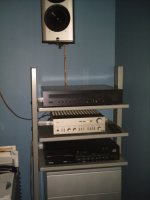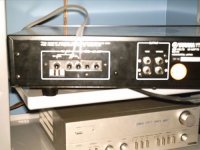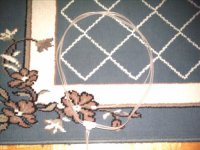Im looking for a good DIY FM antenna for my Yamaha t-1 tuner. Right now im using a dipole and it pulls strong signals very well. But, i want to catch 99.9 here in montreal, which is a notoriously difficult one to pull.
Right now, i could catch it in mono/narrow slighlty off-tuning it intentionally. If i hold my dipole vertically, i get a flickering stereo light. So this is fringe reception, i need a little boost to get some nice stereo here.
What are you guys using for indoor FM antennas? A DIY solution interests me. here is what i absolutely need:
- better gain than a standard dipole
- the smaller the better, dont want to have to move furniture for this
- something that doesnt need constant adjustment for each station
shoot away
Right now, i could catch it in mono/narrow slighlty off-tuning it intentionally. If i hold my dipole vertically, i get a flickering stereo light. So this is fringe reception, i need a little boost to get some nice stereo here.
What are you guys using for indoor FM antennas? A DIY solution interests me. here is what i absolutely need:
- better gain than a standard dipole
- the smaller the better, dont want to have to move furniture for this

- something that doesnt need constant adjustment for each station
shoot away
It's perfectly possible and not difficult or expensive to build your own antennas - a member of the amateur radio fraternity would probably be happy to help you with it - but I think you'll have to compromise in order to balance your requirements.
To achieve more gain, your antenna must be more directional. In the case of a Yagi array (the usual type for domestic FM), this is achieved by adding directors and reflectors, which increases the overall size of the antenna. The extra directionality will make it necessary to rotate the array to receive different transmitters.
The only option I can think of is a switched pair of dipoles, one of which is dedicated to your DX station, perhaps with a VHF amplifier added.
All sorts of designs have been tried - some of which use materials such as aluminium foil and cardboard, so cost virtually nothing - you can have a lot of fun experimenting once you grasp the theory.
Whatever you settle on, make sure that it's properly impedence matched to your feeder and tuner - a great deal of signal loss can be due to a mismatch here.
Good luck!
To achieve more gain, your antenna must be more directional. In the case of a Yagi array (the usual type for domestic FM), this is achieved by adding directors and reflectors, which increases the overall size of the antenna. The extra directionality will make it necessary to rotate the array to receive different transmitters.
The only option I can think of is a switched pair of dipoles, one of which is dedicated to your DX station, perhaps with a VHF amplifier added.
All sorts of designs have been tried - some of which use materials such as aluminium foil and cardboard, so cost virtually nothing - you can have a lot of fun experimenting once you grasp the theory.
Whatever you settle on, make sure that it's properly impedence matched to your feeder and tuner - a great deal of signal loss can be due to a mismatch here.
Good luck!
You'd better sacrifice #2 as well. Small antenna's won't get the performance as their aperture is smaller (=less power pickup).
The best result is going to be had by putting your antenna on the roof, and using low loss co-ax to feed your receiver. I'd assume your receiver input is 75 Ohm? So you need 75 ohm co-ax (RG-59 IIRC). If you use a folded dipole it will have a 300 ohm impedance, so you will want a 4:1 balun to connect to your coax.
The best result is going to be had by putting your antenna on the roof, and using low loss co-ax to feed your receiver. I'd assume your receiver input is 75 Ohm? So you need 75 ohm co-ax (RG-59 IIRC). If you use a folded dipole it will have a 300 ohm impedance, so you will want a 4:1 balun to connect to your coax.
TwoSpoons said:You'd better sacrifice #2 as well. Small antenna's won't get the performance as their aperture is smaller (=less power pickup).
The best result is going to be had by putting your antenna on the roof, and using low loss co-ax to feed your receiver. I'd assume your receiver input is 75 Ohm? So you need 75 ohm co-ax (RG-59 IIRC). If you use a folded dipole it will have a 300 ohm impedance, so you will want a 4:1 balun to connect to your coax.
it has to be an indoor solution, i dont have the liberty to pull coax into my room or mount things on the roof.
my tuner has boath 75 ohm and 300 ohm. which is best to use?
still looking for an indoor solution that beats a dipole...
A colinear dipole might help. Though it will need loading coils to get the size down.
Basically, though, you're stuffed if you want gain at 99MHz, and you want it inside. Any solution with gain at that frequency is going to be big - simple physics. After all, the wave length you're after is around 3 metres, so even a proper 1/2 wave dipole is going to be 1.5 metres long.
Basically, though, you're stuffed if you want gain at 99MHz, and you want it inside. Any solution with gain at that frequency is going to be big - simple physics. After all, the wave length you're after is around 3 metres, so even a proper 1/2 wave dipole is going to be 1.5 metres long.
TwoSpoons said:A colinear dipole might help. Though it will need loading coils to get the size down.
Basically, though, you're stuffed if you want gain at 99MHz, and you want it inside. Any solution with gain at that frequency is going to be big - simple physics. After all, the wave length you're after is around 3 metres, so even a proper 1/2 wave dipole is going to be 1.5 metres long.
well if its big but concealable, i dont mind, i just dont want something that doesnt looks like those big roof top antennas in my room. i dont mind something the size of a standard dipole, only mine isnt performing for me.
do you have more info on colinear dipoles and how i would build one?
thanks for the help, appreaciate it
homer09 said:well if its big but concealable, i dont mind, i just dont want something that doesnt looks like those big roof top antennas in my room.
A good FM antenna will be big, and most likely look like one of the roof-top antennas...
But it could still be concealable if you make one yourself using thick copper wire instead of aluminium tubes - that way you could make it flat at least.
Best regards,
Mikkel C. Simonsen
Thanks dnsey,
Here is my current setup: i have this tuner:


a write up for the t-1 is available here:
http://www.fmtunerinfo.com/yamaha.html
note: this tuner is much better already than a technics tuner i was using previously (techincs st-c03)
i took a pic of the back of the tuner, but it really isnt clear since my camera is very bad. It basically consists of a 75ohm input, a 300 ohm input and an AM antenna input. (the dipole is currently connected in the 300 ohm input)
Also is a picture of a standard dipole antenna you can buy at any electronics store for a few dollars.
my room is located on the second floor, close to a window.
Here is my current setup: i have this tuner:


a write up for the t-1 is available here:
http://www.fmtunerinfo.com/yamaha.html
note: this tuner is much better already than a technics tuner i was using previously (techincs st-c03)
i took a pic of the back of the tuner, but it really isnt clear since my camera is very bad. It basically consists of a 75ohm input, a 300 ohm input and an AM antenna input. (the dipole is currently connected in the 300 ohm input)
Also is a picture of a standard dipole antenna you can buy at any electronics store for a few dollars.
my room is located on the second floor, close to a window.
Attachments
TwoSpoons said:Ah, I thought as much. I too have one of those nasty ribbon antenna's. And my one is crap .
So there's hope for you yet!
This site shows you how to build a similar antenna, but tuned closer to your weak station. I'd try that first as its quick, cheap and easy.
Thanks, i will try this!
will connecting the crossbar of the antenna with 75-ohm coax be better than using more 300 ohm twin lead? i noticed the apparently very good FM Reflect dipole from C. Crane
http://www.ccrane.com/fm-reflect-antenna.aspx
uses 75 ohm to terminate. any other insight between the differences between this FM Reflect and a standard dipole?
TwoSpoons said:Ah, I thought as much. I too have one of those nasty ribbon antenna's. And my one is crap .
So there's hope for you yet!
This site shows you how to build a similar antenna, but tuned closer to your weak station. I'd try that first as its quick, cheap and easy.
What's the difference? Is the 300ohm wire much better than that used in the ribbon antenna?
As Twospoons pointed out, a straight dipole is terminated at 75 Ohms, and a folded dipole at 300. (Actually it's a bit more complicated, especially if you start adding elements...).
What the DIY site describes is a folded dipole:
_____________________________________ |__________________ _________________|
| |
so it needs a 300 Ohm cable.
The Drake looks like a straight dipole:
_______________________ ___________________
| |
and will therefore require 75 Ohm cable.
EDIT: The site doesn't like my diagrams, but I hope you understand what I mean!
What the DIY site describes is a folded dipole:
_____________________________________ |__________________ _________________|
| |
so it needs a 300 Ohm cable.
The Drake looks like a straight dipole:
_______________________ ___________________
| |
and will therefore require 75 Ohm cable.
EDIT: The site doesn't like my diagrams, but I hope you understand what I mean!
jimbo1968 said:
What's the difference? Is the 300ohm wire much better than that used in the ribbon antenna?
i have read that some wire used in cheap dipoles doesnt even have 300ohm impedence, some have closer to 200. thats one improvement.
second, my dipole is almost 6' long, which is terrible considering that is optimized for 78 MHz, when FM is 88-108 MHz and my problem station is 99.9 MHz. this will be the second improvement.
Still wondering about that FM reflect antenna and if anyone has any insight on how it is built inside?
An externally hosted image should be here but it was not working when we last tested it.
dnsey said:As Twospoons pointed out, a straight dipole is terminated at 75 Ohms, and a folded dipole at 300. (Actually it's a bit more complicated, especially if you start adding elements...).
What the DIY site describes is a folded dipole:
so it needs a 300 Ohm cable.
The Drake looks like a straight dipole:
and will therefore require 75 Ohm cable.
Sorry what is the "Drake" is this the antenna i just posted a pic of? Because if it is, this one looks like a folded dipole to me, notice in the picture there are two runs of coax... how could it be using 75 ohm then?
I have no idea where I got 'Drake' from!!
I was referring to the FM Reflect, which looked to me like a straight dipole, but I see from the larger pic that it's not.
As I said, it's not really as straightforward as all that (what is?) - the impedence actually varies with the point of attachment of the feeder. It's also quite possible that the two runs of the Reflect are not electrically conected - one may well be acting as a parasitic element.
The best feeder for a simple ribbon folded dipole, however, is 300 Ohm.
I'd be a bit dubious about the reports of some feeders being 200 Ohm - it's possibly so, but not an easy thing to measure, and will vary according to various extrinsic factors, so I wouldn't worry too much.
Just for fun, I've read that a pair of 'Slinky' spring toys arranged as a dipole can be very efficient - might be worth a try: cheap copies are available here in 'Pound Stores'.

I was referring to the FM Reflect, which looked to me like a straight dipole, but I see from the larger pic that it's not.
As I said, it's not really as straightforward as all that (what is?) - the impedence actually varies with the point of attachment of the feeder. It's also quite possible that the two runs of the Reflect are not electrically conected - one may well be acting as a parasitic element.
The best feeder for a simple ribbon folded dipole, however, is 300 Ohm.
I'd be a bit dubious about the reports of some feeders being 200 Ohm - it's possibly so, but not an easy thing to measure, and will vary according to various extrinsic factors, so I wouldn't worry too much.
Just for fun, I've read that a pair of 'Slinky' spring toys arranged as a dipole can be very efficient - might be worth a try: cheap copies are available here in 'Pound Stores'.
- Status
- This old topic is closed. If you want to reopen this topic, contact a moderator using the "Report Post" button.
- Home
- General Interest
- Everything Else
- DIY FM antenna, can it be better than radioshack junk?



